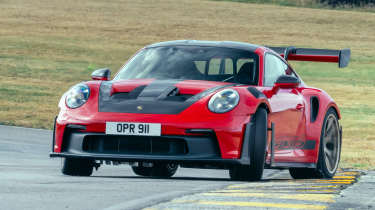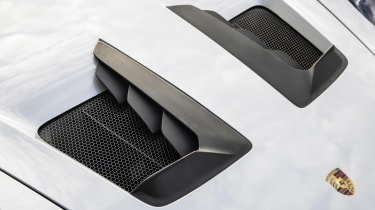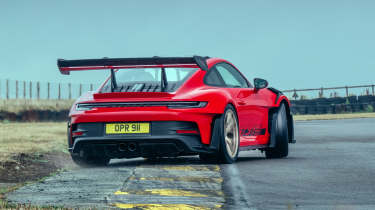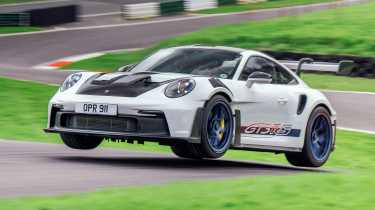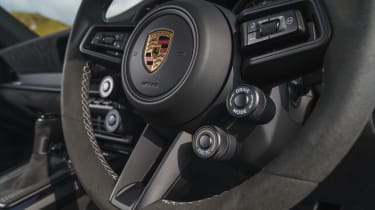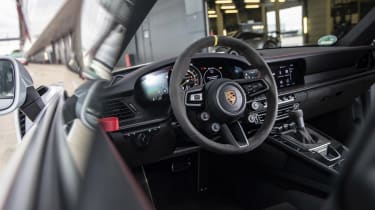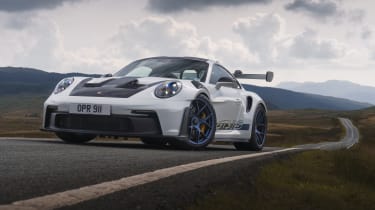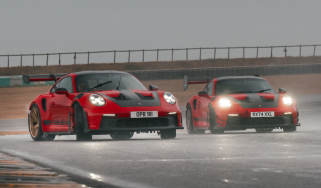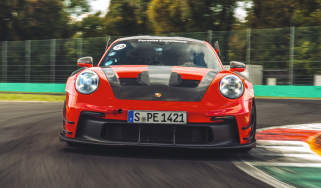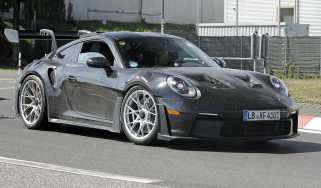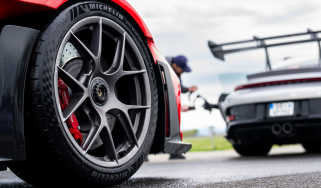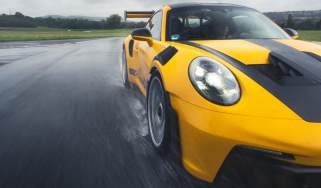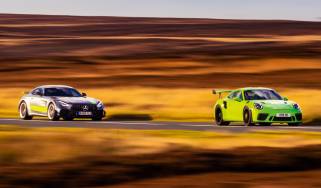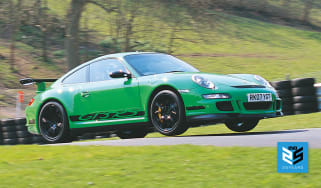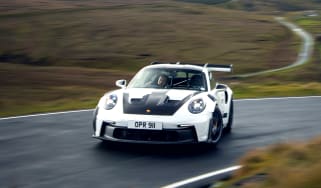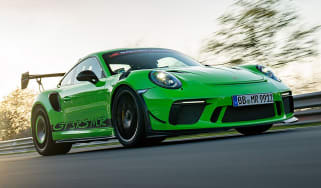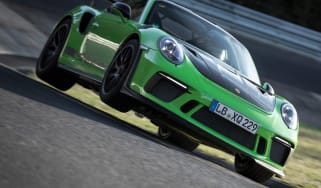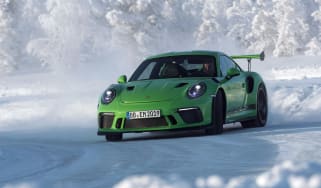Porsche 911 GT3 RS (992) review – the best road and track car money can buy
Porsche’s most extreme GT3 RS yet is also one of the most captivating. As a do-it-all road and track car, nothing can match it
Predictable, isn’t it? The 992-generation GT3 RS is yet another brilliant Porsche GT product, one that regularly traded hands for well over its list price at launch, and had speculators hounding their local dealer for a build slot. Same old, same old. But though the formula is familiar, the 992 RS is truly something special, and groundbreaking in the world of Porsche GT cars. It’s just about the most extreme and ambitious RS ever, one that deserves to be pounding around Spa or Silverstone rather than sitting in an air conditioned garage with no miles on the clock.
For the lucky few that own one, the rewards for exercising the RS in its intended environment are stratospheric, no matter the conditions, the circuit or your skill level. More than ever, Porsche has pushed every area to squeeze every last drop of performance from the package, and you only need to look at its distended, outrageous and brutally functional shapes to realise this. It’s just plain bonkers.
We were blown away by the results of this intense development programme at both our 2023 evo Car of the Year and 2024 Track Car of the Year tests. The RS won both, demonstrating that Porsche’s ability to produce an utterly absorbing road car that can annihilate a racetrack is still in full force. It’s quite simply one of the best RS’s ever produced, and with a second-gen 992 RS on the horizon, we eagerly await to find out if, and how, Porsche can make it any better.
Engine, gearbox and technical highlights
- Naturally-aspirated flat-six lives on, with more power despite emissions regs
- The most extensive aero package of any 911, with more downforce than a 992 Cup car
- Damper and diff settings configurable on the fly
More reviews
In-depth reviews
- Porsche 911 Carrera GTS T-Hybrid review – the first hybrid 911 is one of the best
- Used Porsche 911 (991, 2011 - 2018) review – should you buy the unloved 911?
Long term tests
Reviews
- New Porsche 911 Turbo S review – the more rounded McLaren Artura rival
- RML GT Hypercar review – the Porsche 911 taken to the ultimate extreme
- Used Porsche 911 (997, 2004 - 2012) – the ultimate sweet spot 911
- Porsche 911 Turbo S (992.1, 2020 - 2024) review – Stuttgart’s supercar slayer
- Porsche 911 3.2 Carrera (1984 - 1989) review – flawed but furiously charming
Despite the radical trackday makeover there’s reassuring familiarity in the RS’s 4-litre naturally aspirated flat-six and seven-speed PDK transmission. The motor really has been squeezed until its pips squeak to find an extra 15bhp in the face of stringent emission regs. This gain lifts the total to 518bhp at 8500rpm thanks to the adoption of RS-specific cylinder heads, camshafts and throttle bodies (now one per cylinder).
Airflow management has also been optimised to ensure hot air is channelled along the flanks of the car, while colder, denser air runs over the roof and into the intake scoop in the top of the engine cover. Against the clock 0-60mph arrives in 3sec, 100mph in 6.9. Top speed is 184mph, some 14mph down on the GT3 despite a DRS function that stalls the rear wing.
There’s so much detail to unpack, but so much of it seems like it would be irrelevant for the road. The RS is a downforce monster and a great deal of the engineering in the car is to create phenomenal load and utilise it as best as possible. It defines the entire car – from the single, centrally mounted radiator that lives where once your overnight bag would go, to the massive swan-neck rear wing with adjustable rake and an operating range of 34 degrees, from low drag to full airbrake deployment. The peak downforce figure – 860kg at 177mph – beats that of a 992 GT3 Cup car and is in the lower range of a full-on 911 RSR set up for the long straights at Le Mans.
You’re unlikely to reach 177mph unless you’re on a runway, so instead let’s examine some of the other intriguing aspects of this 518bhp, 1450kg road car. It is a road car, after all. Most fascinating of all is the suspension, and how it can be adjusted on the fly. The Weissach Package car has carbonfibre anti-roll bars (saving 1.5kg at each end), plus delightfully geeky aero-optimised front control arms and gorgeous magnesium wheels (saving another 8kg). Plus the ability to adjust bump and rebound for front and rear dampers via simple rotary controls on the steering wheel.
Funnily enough, this configurability is only unlocked in Track mode, which is reached by toggling through Normal and Sport modes. To confuse matters further, it’s still possible to stiffen or relax the dampers to a predetermined level in these modes with the damper button on the centre console, as per the standard GT3.
It all sounds head-meltingly complex but, in reality, you find yourself simply driving in Normal mode, or going straight to Track so you can play with the dampers manually. Bump and rebound settings range from -4 to +4 with the default set to zero. Porsche has been careful to ensure that even if somebody selected, for example, full soft on the front and full hard on the rear, the balance won’t be dangerously wayward. When you consider that the RS is fully rose-jointed and has spring rates 50 per cent stiffer than the already uncompromising 992 GT3, you’d imagine that away from the confines of a racetrack it might all be in vain – but somehow it’s not.
If, for whatever reason, all that isn’t extreme enough for you, Manthey Racing produces a £100k upgrade kit for the RS that takes its track performance to even greater heights. New aero elements such as a larger rear wing, front canards and a carbon ‘shark fin’ boost downforce to 1000kg – and amazingly, do so without increasing drag. Meanwhile the suspension is swapped for even stiffer bespoke coilovers with revised electronics (albeit retaining the standard cars on-the-fly adjustability), and braided brake hoses are fitted. The kit is Porsche-approved and thus doesn’t impact the factory warranty.
Driver’s note
‘Downforce is a mysterious and somewhat intimidating entity, but the RS is unusually approachable because the level of challenge and commitment is always matched by a commensurate degree of connection and reward. Technology makes this possible, and the frankly brilliant system of rotary switches and ultra-simple dash display makes it accessible and intuitive to explore.’ – Richard Meaden, evo Editor-at-Large, who tested the Porsche 911 GT3 RS on road and track in the UK
Performance, ride and handling
That scintillating 9000rpm engine and super-sharp seven-speed PDK ’box (now with shortened ratios and final drive for added in-gear snap) is one of the all-time great partnerships. Though not night-and-day different to the GT3, there’s a definite uptick in urgency and intensity.
Perhaps surprisingly, the engine performance is one of the more timid aspects of the RS. Yes, the wonderful, howling, naturally aspirated flat-six that revs to 9000rpm. It sounds so crisp and pure even at low speeds but somehow the low- and mid-range performance seems at odds with what your eyes are relaying and the tense, sinewy responses of the chassis. It’s no coincidence that the 5000rpm marker is located at 12 o’clock on the rev counter. That’s about where things get going.
Even at the glorious, shrieking top end, the 4-litre flat-six is no match for the grip and traction on offer, which might be a frustration for some. Certainly, the needle is swung much further in the direction of grip than power, which is unusual in this world of the 473bhp BMW M2 or an 819bhp ‘baby’ mid-engined Ferrari. With that said, on the road you’ll be gathering speed at quite a rate if you wring the engine all the way out, and the intensity of the delivery more than makes up for what it lacks in outright gut-punch.
The RS was designed for the track, but the real world is littered with bumps. And catseyes. And crappy road repairs. The 275-section front tyres get hooked into all sorts of grooves and cambers and even within the Normal mode’s operating window the ride is disjointed and busy. The car’s structure feels rock-solid and the rose-jointed suspension never knocks, creaks or rattles, but at low and medium speeds there’s a physical, knuckly feeling to the way the RS gets down a road. Not so much limbering-up as cracking joints in preparation for what lies ahead.
The whole car feels like it’s waiting for more speed and more positivity. The steering is unbelievably responsive; the solid brake pedal is accurate even with gentle inputs, but you sense there’s massive power just waiting to be deployed (amazingly, the carbon-ceramic discs fitted to this car are a cost option); there’s a latent energy that almost demands to be unleashed.
Track mode is pretty much the only mode you’ll ever want. Just as with the GT3 and GT4 RS, stiffer settings seem to settle the whole car down. From bobbly and slightly ill-at-ease, the ride becomes so much more decisive. It’s not supple in the way of a McLaren or Ferrari, but the platform feels so stable and it deals with all but the very worst surfaces with instantaneous efficiency, leaving you to just focus on unpicking the road and unleashing the engine.
It’s a fascinating and sometimes quite surreal experience. In many ways the seeds of the traditional 911 experience are completely gone. On the road at least, this is not a car that requires a unique driving style to exploit. No concessions are required for the peculiar engine position. The RS turns in with startling speed and accuracy. It takes your breath away. Now layer on top the mechanical grip of a chassis with huge roll stiffness that still squeezes the massive tyres into the surface, plus the rear engine’s natural advantages in terms of traction and the result is nothing short of outrageous. Corners no longer have ‘phases’. The RS allows you to overlap turn-in and throttle application to the extent that even roads you know well become brand new. It plays by a different set of rules.
So the 992 GT3 RS requires a mental reset. The thrill comes from carrying speed, from opening up the engine early and living at high revs, from having the chassis fully loaded and being dazzled by the immense turn-in stability, the wonderful, neutral balance and the sheer agility it demonstrates. In itself that’s a bigger thrill than reining a car in all the time, but on the road it does make the RS a curious proposition. To really enjoy its capabilities requires a level of commitment that’s uncomfortable in all but the most remote and empty locations.
Luckily there’s much to enjoy at lower speeds, too. The tactile sensation of the titanium paddles with their magnetic action, the precise throttle mapping, that immensely satisfying steering response and the overwhelming impression that you’re in something that elevates the mundane into something heroic. The rear wing flattening off as the DRS activates in three-tenths of a second should feel a bit silly, for example, but actually it’s oddly cool and exciting. If you couldn’t feel the added aero-enabled stability as speeds rise it would be a nonsense, but the RS is one of very few cars where you can start to feel the downforce work in quicker turns. There’s a wonderful authenticity to the whole experience.
What about the suspension adjustment that could so easily slip into the realms of gimmick? It’s fabulous. The on-the-fly adjustment genuinely creates a greater sense of depth and it’s really enjoyable to play around with different settings and feel how they affect the car’s dynamic responses. Experimenting with the lock-up characteristics of the rear e-diff is also particularly satisfying and allows you to start bringing the rear of the car into play, too, should you want that slightly more rear-led feel that a 911 fan can’t help but crave.
On track
On circuit, GT3s and RSs have always balanced useability, accessibility and capability better than most, but the 992 has an uncanny knack of settling your nerves from the get-go and giving you every possible clue as to where its limits may lie. That may seem contrary to how you might imagine a car which relies on downforce might feel, but the scary-looking RS is eminently approachable.
In dry conditions the Cup 2s take a full lap to switch-on, but after that the RS feels absolutely nailed to the racing line. The charge into fast corners is a huge thrill – engine screaming right near the redline, the invisible hand of stability from the aero, and the ability to slice into the heart of a corner with confidence. You can put full faith in its precision and grip.
Too much throttle too early edges the nose wide, but a more patient approach – and a tweak to the diff settings – can dial some of this out. By and large though, the front-to-rear balance is sweetly matched, and the rate of turn never seems to ask too much from the rear-end. Instead, what you get is an addictive feeling of connection, poise combined with levels of lateral g that are tangible but well beyond those of mechanical grip alone.
It’s during hard braking that the RS plays its other trump card, massive stopping power and uncanny stability allowing you to brake late and deep with absolute assurance and stability. It all combines in an addictive, sustained rush around a lap – as an all round package to be enjoyed on road and track, it really is hard to find weakness in the 992.
Driver’s note
‘Where the RS stands alone is in how it feels relatable to road car drivers while taking them to a new realm of performance, yet also has the ability to stimulate and dazzle drivers with extensive experience of serious racing machinery. To hit such heights on track and still be so brilliant on the road is unprecedented in our experience.’ – Richard Meaden, evo Editor-at-Large, who tested the Porsche 911 GT3 RS on road and track in the UK
MPG and running costs
Porsche claims that the GT3 RS can achieve 21.4mpg, but expect a figure in the teens when using its performance (as much of it as you can, at least) on the road. Aside from fuel, the RS’s consumables will be the biggest factor in how much it costs to run, particularly if you use it on track.
A set of Michelin Cup 2 front tyres will cost you upwards of £600, and the mammoth 21-inch 335-section rears will cost around £1000 for a pair. Wear through the ceramic brakes and you’ll be looking at a much bigger bill – Surface Transforms offers upgraded and supposedly more durable ceramic discs for around £15k, although these can be resurfaced up to three times for a total lifespan of 10-15,000 track miles.
That’s a tough pill to swallow, but when you consider that the RS can outperform a lot of purpose-built trackday machinery, the costs involved in running one as a track car sting a little less. And if you have no plans to use it on a circuit, the bills won’t be alarming for anyone that has run a supercar of this calibre before.
Interior and tech
The RS’s driving environment is fantastic and the steering wheel is so small, but with the seat wound down low the widened Turbo shell seems to sprawl around you. No complaints about the quietly serious messages that whisper from everything you touch or see, though. From the taut Alcantara trim to the satin-finish carbon for the door handles, the RS feels at once pared-back and reassuringly solid – fittingly, like a car you wouldn’t hesitate to jump into for a double stint through the night. The view out over the vented bonnet is evocative of the shrill whizz of wheelguns and that thick smell of hot tyres, too.
The side mirrors are full of gaping intakes, and the rear wing is so tall it would afford a fantastic view were it not for the thick spars of the oddly shaped but gorgeous carbonfibre roll-cage (part of the £29,600 Weissach Package, which also includes things like the titanium paddleshifters and visible carbonfibre for the exterior, accompanying the aforementioned carbon anti-roll bars and mag wheels). Annoyingly, the lack of a front boot and the rear cage means there isn’t a suitable place to store a lid, which seems like an oversight.
Hot air streams through the vented bonnet to such an extent that the world occasionally seems to be in soft focus. But it is the real world, full of vans, hatchbacks and SUVs. The RS feels like a superhero in line at the supermarket check-out. Having said that, it still has the same PCM infotainment system you’d find in a regular Carrera, as well as a part-digital dash. All the niceties you’d expect from a modern sports car are present, albeit shrouded in a pared back, single-minded driving environment.
Price and rivals
Availability of the RS is currently limited as Porsche readies an updated 992.2 version. Its £192,600 starting price places it well into the big leagues, and into the world of bespoke supercars like the Maserati MC20 and McLaren Artura. But we can tell you without reservation that the 992 GT3 RS is the biggest single step on in the RS lineage since the 996 GT3 RS arrived back in 2004. It’s a truly sensational machine. Even more dramatic in the metal than it is in pictures, it makes a 992 GT3 look like a Carrera and is worth the £30k+ price premium on kerb appeal alone.
The McLaren Senna is perhaps the closest modern road car to the RS in terms of outright track focus, but Woking's offering was almost four times the price, and strictly limited to just 500 units. The Maserati MC20 GT2 Stradale has a similar road racer vibe but gets nowhere near the Porsche’s level of precision, capability and breadth – even if it is quicker in a straight line.
You need to look at highly specialised, bespoke machinery to get anywhere near the RS’s blend of engagement on the road and circuit capability. At our 2024 Track Car of the Year test the RS was a few hundredths quicker than a Radical SR3 XXR around Cadwell Park, and 0.3sec quicker than Ariel’s Atom 4R. Only the Australian Spartan track car and Revolution racer beat it around the lap, which makes the RS something of a bargain as a do-it-all road and track machine.
Porsche 911 GT3 RS (992) specs
| Engine | Flat-six, 3996cc |
| Power | 518bhp @ 8500rpm |
| Torque | 343lb ft @ 6300rpm |
| Weight | 1450kg (363bhp/ton) |
| 0-62mph | 3.2sec |
| Top speed | 184mph |
| Basic price | £192,600 |
